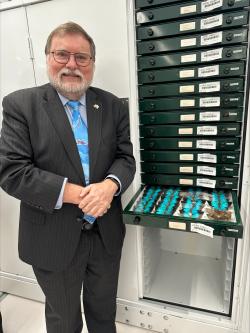On Thursday 14 August 2025, Prof Haymet delivered a speech at the opening of the new CSIRO National Research Collections Australia facility in Canberra.
Some of you know that I was lucky enough to join CSIRO at the end of 2002, and I found that I had a dream team of employees as I led the Hobart laboratory, and marine and atmospheric labs around Australia. And Toni Moate was one of those people and I would like to shout out to Toni Moate and to a very special scientist, Peter Last, who many of you know from Collections. Known by the nickname Scary, which I never really figured out, but Scary and Toni really taught me the value of collections.
In Hobart, there is a fish collection of which I became incredibly proud of, and a living algae collection, and later on when I inherited the atmospheric science lab, there was a collection of air in Aspendale. Every year, CSIRO scientists take the sample of air from Cape Grim and store it away, and like all collections—and that is the important thing about today—they become more valuable each year because they are a way of going back in time and analysing what was happening in the world, and in Australia, years ago.
I like to tell the story of NF3, a man-made molecule that doesn’t occur naturally in the world, that is a by product of making electronic TV sets. One of my colleagues went to the Cape Grim collection in Aspendale and traced the exponential rise of NF3 in our atmosphere from that collection, dialling back in time to see when it was that mankind was injecting the greenhouse gas nightmare of NF3 into our atmosphere.
After being well educated in Hobart, I went on to run the Scripps Institution in San Diego. Scripps has 4, very large marine collections, including:
- marine geological samples
- marine vertebrate
- pelagic invertebrate
- benthic invertebrate.
All supporting science and education. And let me give you a tip: don’t ever suggest that the pelagic collection should be amalgamated with the benthic collection. You’ll offend just about every marine scientist in the world!
Collections have always been in my life and, I think that Doug probably will support this, they are the hardest thing to raise money for because every government wants you to explain:
What’s the value of the collection?
How much would it cost to replace the collection?
Well, they are irreplaceable. Because they are historical collections. You can never go back 30, 40, 100 years and replace those samples.
But equally, they become more and more valuable each year. As our analytical chemistry techniques get better and our DNA analysis techniques get better, we can extract more and more from those collections as time goes on.
We’ve seen with the advent of digital photography that for people who want to write a book about fish, they don’t have to go to Hobart or to San Diego to do that, because we have high-resolution photography. It means they can sit at their desk and do almost all their research by looking at high-resolution photographs of samples. And if they find something they need to see to finish that book, then they can make a quick and efficient trip.
I want to congratulate everyone in Australia who has had a hand in all the collections. This new facility is a testament to our national commitment to understand and protect our natural world.
The work that will evolve here is nothing short of essential, because biodiversity is the lifeblood of our nation. Among other things, it sustains our agriculture, secures our natural resources, helps to preserve Indigenous knowledge and defines the unique beauty of our landscapes.
It touches everything we are and everything we hope to be.
This facility is more than steel and concrete. It is a beacon of scientific discovery, collaboration and innovation.
The research conducted here won’t just help protect Australia’s ecosystems, it will also shape the conservation strategies and policies that influence our future.
Today marks a significant milestone and I count myself lucky that the opening of this building fell during my term as Chief Scientist. It reminds us that investing in biodiversity research is an investment in Australia’s natural legacy and global leadership.
It fills me with hope and pride and is a cause for great celebration.
Congratulations!

